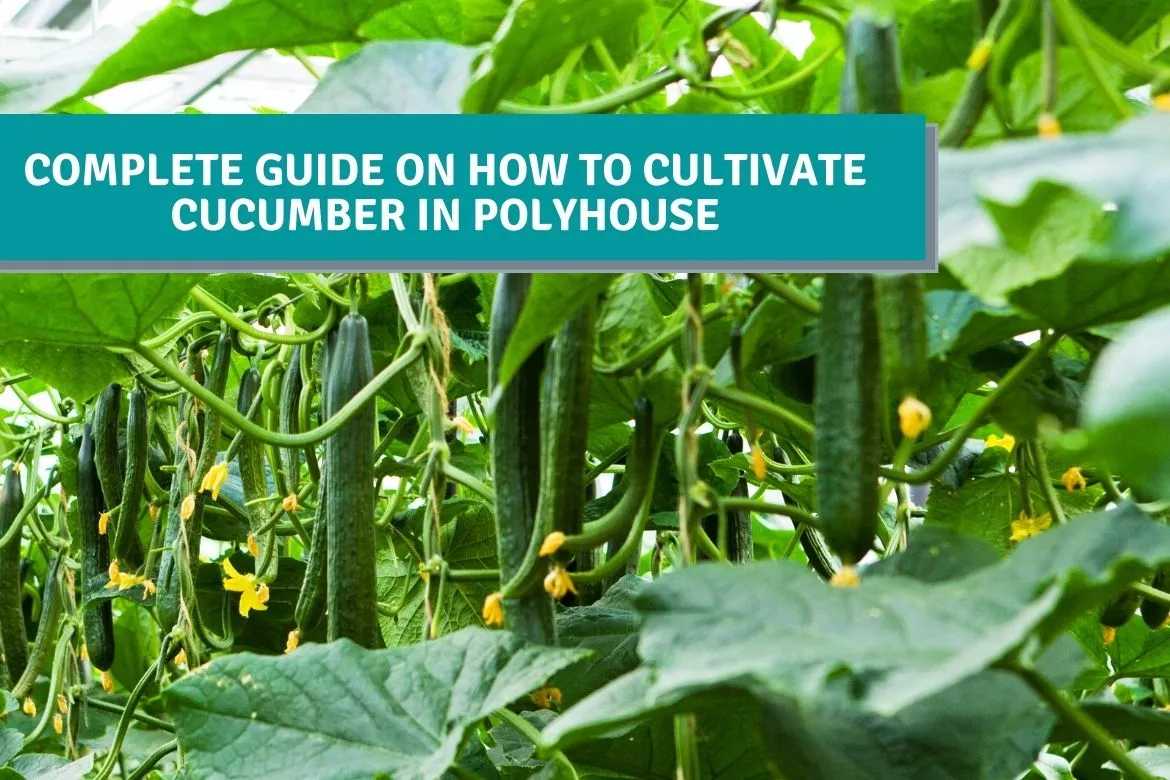Table of Contents
Introduction to cucumber
Cucumbers (Cucumis sativus L.) are among the most popular and important vegetables cultivated worldwide. It is often eaten raw. In India, it has been used as a food and medicine since ancient times. An oil extract from the cucumber seed is excellent for the body and brain. The water content of cucumber is approximately 96%, making it a great summer season vegetable for snacking or juices.
In many countries of the world, the Practice of cultivating cucumber in polyhouse is very popular. Cucumbers are best grown in sandy loam soils containing high organic matter, good drainage, and having an electric conductivity less than 2 dS/m and pH levels between 6.5 and 7.5.
Cucumbers grown in protected areas yield a higher yield and higher quality than those grown in an open field.
Climates that are moderately warm permit better cucumber growth. A yellow-coloured flower grows on plants with triangular hairy leaves and hairy stems.
Cucumber is a wonderful source of molybdenum, vitamins, and potassium. Nutrients in cucumber help with skin problems, kidney problems, heart problems and is a great alkalizer. Additionally, cucumbers are a good source of calcium, magnesium, and folate.Additionally, it contains silica, which is essential for strengthening and connecting tissues, and it relieves joint pain. There is also hecopene, secoisolariresinol, lignan, lariciresinol and pinoresinol in cucumber. These phytochemicals work together to reduce the risks of different kinds of cancers.
Originally, cucumbers come from south Asia, specifically the warm and humid climate of northern India and possibly northern Africa. When provided with sufficient amounts of water and nutrients, its best performance can be expected under high temperatures, humidity, and light intensity. Cucumber cultivation is known to have begun in India at least 3000 years ago, and in China during 100 B.C.
Soil Requirement to cultivate cucumber in polyhouse
In order to grow cucumbers, it is necessary to have a well-drained, well-structured, fertile soil with high porosity. A stable soil structure and high porosity are essential with frequent water supply.
It is recommended to apply a large amount of organic matter and compost in order to create these conditions. Cucumbers do well in sandy loam soils with a pH of 5.5 to 6.5.
Preparation of soil
More than 80 per cent of cucumber roots spread to a depth of 20 cm in the soil. Cucumbers have a limited ability to tolerate drought, flooding, and low temperatures.
To ensure good aeration for cucumber, the soil preparation should be done as carefully as for other vegetables. Raised beds and flat beds can both be used in polyhouse.
An ideal bed size ranges from 60-100 cm in width, depending on distance between rows, and 25-30 cm in depth. Cucumber beds should have a finer top layer of soil than their subsoil layers. You can cover raised beds with plastic mulch.
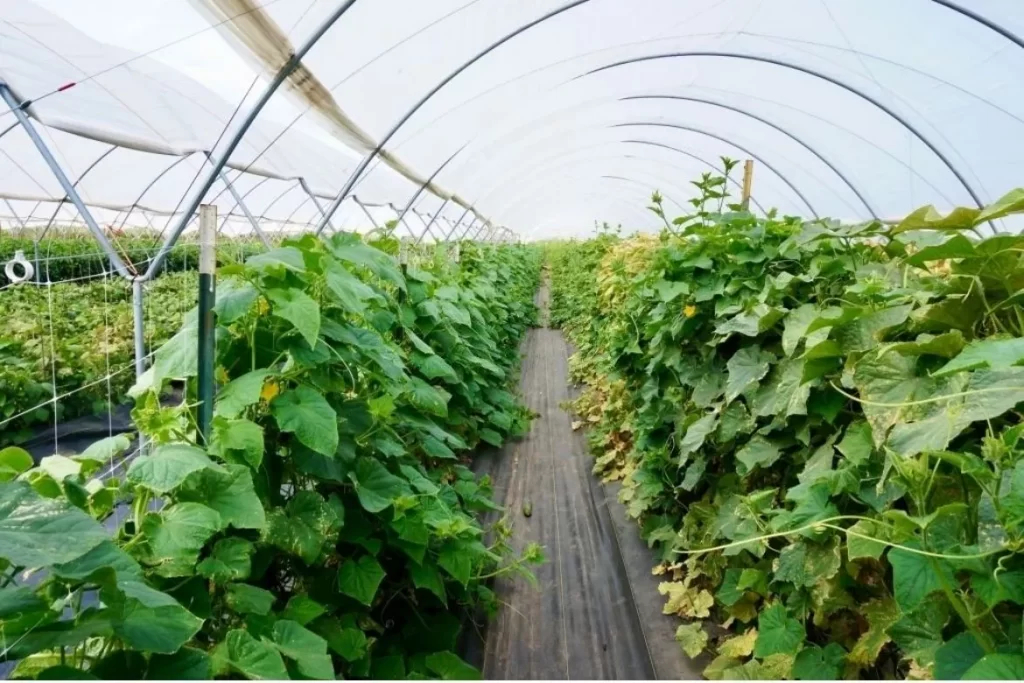
There are numerous benefits of plastic mulch, such as weed control, soil temperature maintenance, and reduction of water loss, all of which increase cucumber yield.
Make sure to put the plastic mulch when the soil is a little moist.
It is best to lay plastic mulch in the afternoon, so that it is more pliable and stretches better for a tighter fit.
Apart from soil, you can also use other growing medias. Rockwool is a popular preferred growing medium worldwide. Additionally perlite and pumice can also be used as growing media to cultivate cucumber in polyhouse. Bags or slabs can also be used for cucumber farming in polyhouse. To use these as growing medium, a height of 15-30 cm must be maintained.
It is very important that salinity levels of the soils to be low. Cucumber yeild will decrease in soils with high salinity.
At initial stages of plantation, elelctrical conductivity needs to be about 2 dS m-1. During growing stages, the electricity conductivity can be maintained at 2.5 dS m-1(Savvas et al. 2013).
Temperature requirement for cucumber farming in polyhouse
Atmospheric temperature plays a major role in plant growth, flower initiation, fruit growth and quality.
To grow cucumbers faster, an ideal temperature of ≤ 25°C must be maintained.
The average temperature for germination is between 25 and 35 degrees Celsius with good soil moisture, and germination takes 2-3 days.
Temperatures below 13–15°C cause shoots to not grow properly.
At max, cucumbers can tolerate temperatures around 38°C to 40°C. Such temperatures can easily be maintained for farming cucumber in polyhouse.
Planting of cucumber in polyhouse
Transplanting is the main method of growing cucumbers in poly houses. However, direct seeding in bed can also be done but only in the season of autumn or late summer when the temperatures are high enough for seeds to germinate well.
When transplanting cucumbers properly, farming of cucumber in polyhouse can be successfully accomplished.
Low soil temperatures can damage the root system of young seedlings and restrict their growth. Conversely, an overgrown or aged seedling is unable to grow when transplanted.
For establishing a stand of cucumbers, you should plant cucumber seeds deep in soil and irrigate them immediately after planting. Irrigation helps the plant to withstand temperature variations during day and night.
Plant Density for planting cucumbers in polyhouse
In a polyhouse, plant density is determined by light conditions, plant growth stage, and pruning technique.
It should also be considered that it is possible for leaves to shade and overlap.
Cucumber plants need about 0.5 meter square area and a good source of sunlight in open field conditions. However, in areas with low lighting, more space will be required.
In polyhouse, a closed protected farming system, the recommended plant density of 2.2 – 2.5 meter square works well for farming of cucumber.
Plant spacing depends on how growers prefer to arrange their rows and plants. It is recommended, however, to space rows 1.2-1.5 meters apart and to space plants 0.40-0.45 meters apart.
Treillage of cucumber plantation in polyhouse
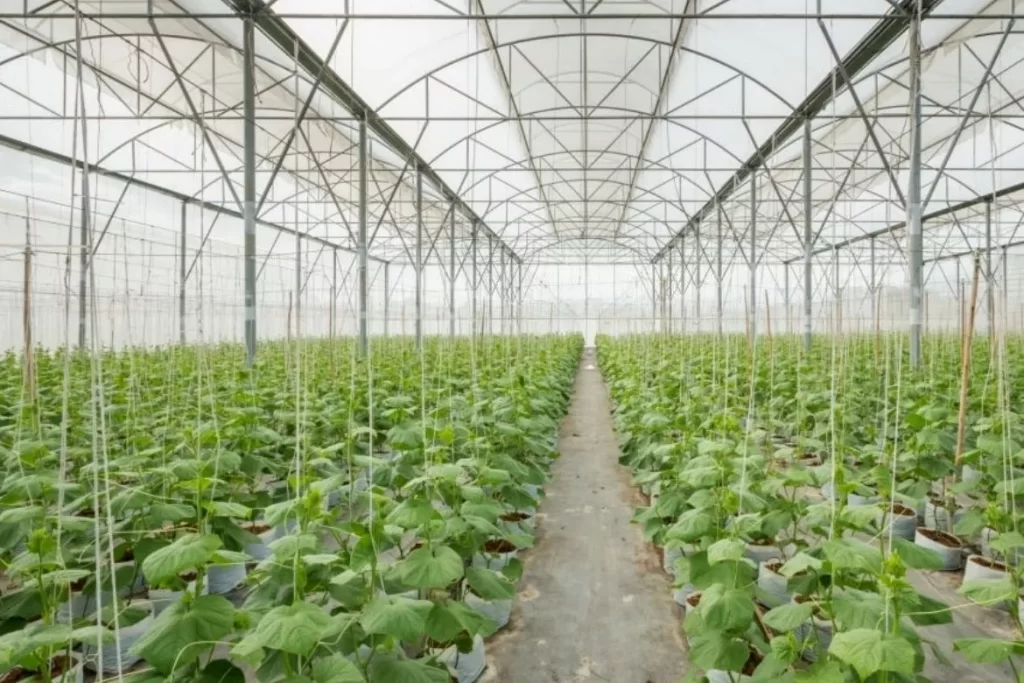
Different methods are used by growers depending on their preference and the availability of materials for the purpose of trellising. One of the factors determining the technique to be used is the availability of sunlight. Wire and string techniques are the most common preferred methods of treillage.
Pruning of cucumber plantation in polyhouse
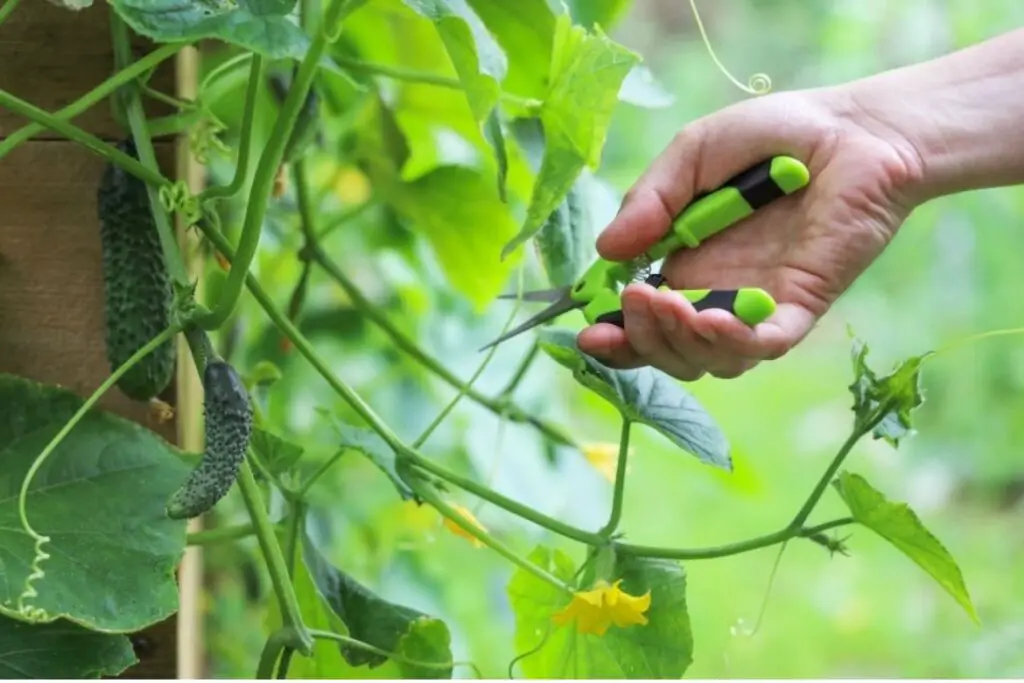
Fruit load must be balanced with vegetative growth during the growth cycle to maximize cucumber yield.
Pruning of shoots, foliage and flowers at the recommended intervals is very crucial. Additionally, even pruning of fruits is essential because overloading the plant with fruits might lead to discoloured and malformed cucumbers.
As a thumb rule, one long fruit per axial is recommended. However, as you gain more experience and knowledge, you can experiment with more than one fruit per axial.
Make sure to remove the lateral branches, flowers and tendrils for 7-8 leaf nodes.
In order to train plants into single stems, all lateral branches should be removed.
As the new leaves appear on the upper part of the stem, the bottom leaves are gradually removed.
Plants that have been supported by wire can reach a growth of up to 20 cm in height.
Irrigation of cucumber plants in polyhouse
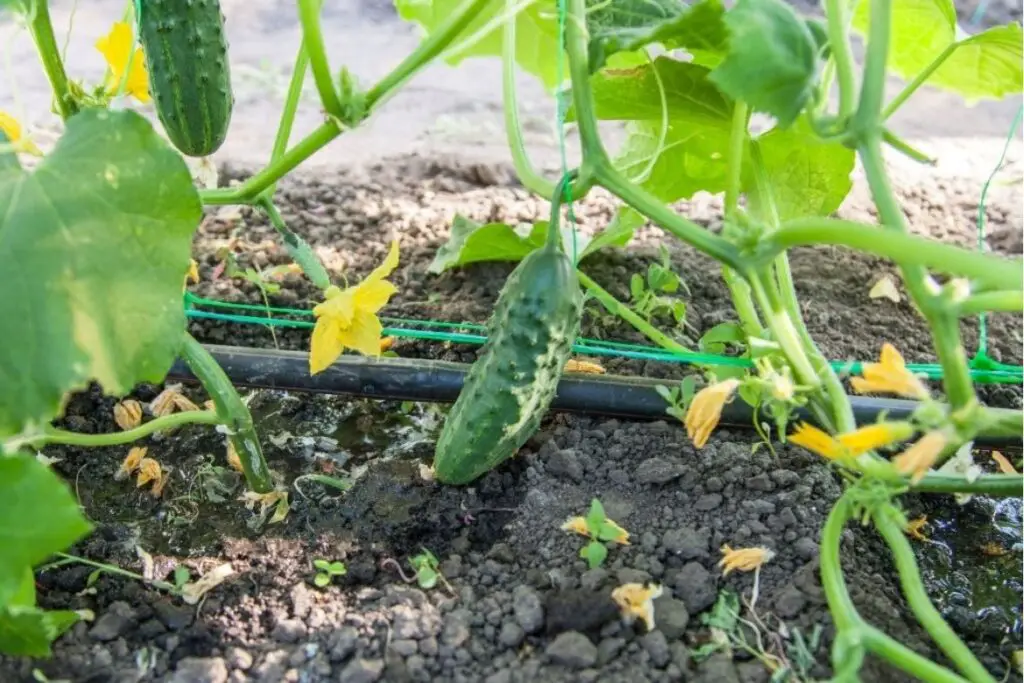
Both yield and product quality are affected by irrigation management. Since cucumbers need a lot of water, frequent irrigation is necessary. In order to maintain an adequate supply of oxygen to roots, sufficient water and aeration have to be maintained in the root zone.
There are many factors that determine how much water cucumber plants require each day, such as temperature, light intensity, relative humidity, and plant density.
If light sandy soil is used, then the frequency of watering the plans is increased as the sandy soil loses moisture fast.
The use of mulch reduces evaporation so that irrigation is significantly reduced when it is applied.
Cucumbers grown in polyhouses are best irrigated with drip irrigation.
The irrigation water should have an electrical conductivity of < 1 dS m-1 and should be a little acidic.
Fertilizers for cucumber plants in polyhouse
There is no cookie-cutter formula for the application of fertilizers when farming cucumber in a polyhouse. The application of fertilizers is solely based on the soil nutrient content.
Application of fertilizer also depends on the type of soil. It is recommended to conduct a soil test so that well-educated decisions regarding use of any type of fertilizers should be made. This is very crucial as the cucumber plant requires a high quantity of nutrients, however, it is also very sensitive to the variation or excess of nutrients.
Cucumber are 90% (approx) water and they retain a lot of chemicals used while growing cucumber plant. This also is one of the reasons why fertilizers should be used cautiously.
Application of fertilizers based on frequent soil analysis is recommended.
*Must read : Bio fertilizers
Harvesting of cucumber from polyhouse

Depending on the cultivar chosen, the climate conditions and the technology used, cucumbers can be harvested within 30-35 days of transplantation in good conditions. Approximately 8-10 harvests can be done.
Cucumbers are mainly harvested at their immature stage, right before they reach their full ripeness.
The price of mature cucumbers is lower, and if left on the plant, over maturity reduces cucumber plant yield.
It is best to harvest cucumbers in a cool climate since excessive heat damages cucumbers.
Harvesting should be performed with clean, sharp tools in order to ensure minimal damage and disease spread.
Post-harvest management of cucumbers
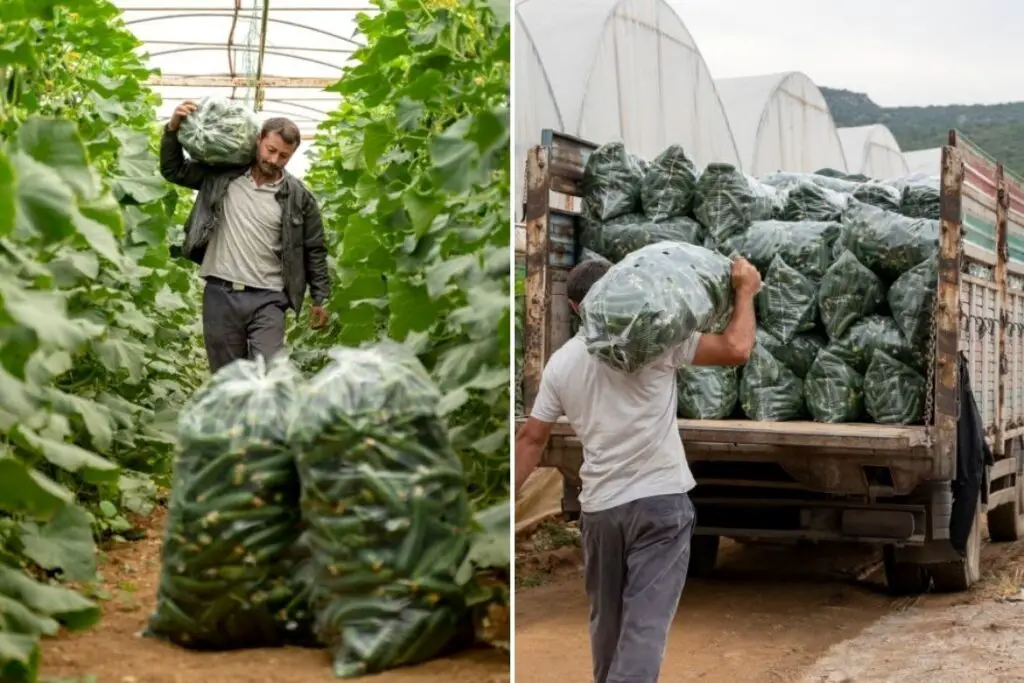
Due to cucumbers losing moisture content and becoming soft right after harvest, it should be transferred to the cold storage immediately.
Cucumbers should be stored in clean, dry containers, away from direct sunlight after harvesting and moved to packing houses immediately.
Care must be taken while harvesting to avoid any damage to the skin. Damaged skin reduces the sale price of cucumber.
When storing cucumbers in cold storage, the optimal temperature should be between 10 and 12.5 degrees Celsius and the relative humidity should be 95 %.
Conclusion
Cucumbers rank second in cultivated cucurbit popularity after watermelons. China is the biggest producer of cucumbers and the second-largest producer of cucumbers is India.
A four-month cycle of harvesting cucumbers in a polyhouse can yield almost 70 Tonnes of cucumbers in one-hectare area of polyhouse. And a farmer can run 2 such harvest cycles per year.
The approximate yield of cucumbers in 1 acre polyhouse can be 28 tonnes on average.
FAQ
Is cucumber farming profitable? Yes. the yeild of cucumbers produced in polyhouse makes cucumber farming a decent profitable business. Yield 1 hactare/ 4-month cycle = 70 tonnes. Yield 1 Acre/4-month cycle = 28 tonnes. There are 2 such harvest cycles per year.
How long does it take for cucumbers to produce? Cucumbers can be harvested in 30-35 days after seeling plantation. Provided appropriate climate control, soil nutrition and irrigation is maintained.
What is the best time to plant cucumber? The recommended months to plant the seeds or seedlings is January- April or June. But in high technology polyhouse, the plantation can be done any time.
What is the seed rate of cucumber farming in polyhouse? Approximately 2.5 to 3 kg of seeds are enough / hactare.

